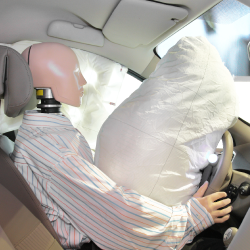 |
In most of today’s world, modern life is unimaginable without the automobile. This century-old invention has liberated millions from having to live in or near their workplaces. Along with telecommunications and electricity, it has accelerated economic growth, lifting millions out of poverty. The automobile has also helped the physically challenged to live fuller lives. 
|
The undeniable advantages of automobiles have come at a terrible price—and arguably an avoidable one. From developing nations such as India to first-world mainstays such as the USA, traffic fatalities far outnumber deaths from war and terrorism. A key goal of modern automobile design is to make cars safer in a collision. 
|
That wasn’t always the case, some say. When Ralph Nader published Unsafe at Any Speed: The Designed-In Dangers of the American Automobile in 1965, cars did relatively little to protect their occupants if a crash occurred. In physics terms, they did little to reduce the rate at which an occupant came to a stop. Air bags were all but nonexistent, body frames rigid, and car interiors riddled with hazards. Fortunately, automobile design no longer ignores the laws of momentum. 
|
 A combination of inertia and motion, momentum can only be transferred by enduring a force. Imagine riding in a car that hits a brick wall at 30 mph (13 m/s). Impart your body’s momentum to the dashboard in 1/20th of a second, and you almost certainly will leave the scene in an ambulance. Encounter an air bag, and your collision may last a leisurely quarter-second—often enough to let you walk away unharmed.
A combination of inertia and motion, momentum can only be transferred by enduring a force. Imagine riding in a car that hits a brick wall at 30 mph (13 m/s). Impart your body’s momentum to the dashboard in 1/20th of a second, and you almost certainly will leave the scene in an ambulance. Encounter an air bag, and your collision may last a leisurely quarter-second—often enough to let you walk away unharmed.
Progress doesn’t end with air bags, which now protect riders from side impacts as well as from dashboards and steering wheels. Materials scientists, physicians, and engineers are working to develop car bumpers that protect a car’s occupants as well as any pedestrians who might be struck. And automated, driverless cars, which could avoid collisions altogether, appear to be right around the corner. Understanding the physics of momentum transfer promises to reduce the number of lives lost every year to car accidents. 
|
| |
|

